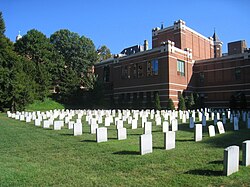Georgetown University Jesuit Community Cemetery
| Georgetown University Jesuit Community Cemetery | |
|---|---|
 Cemetery in 2010 | |
 | |
| Details | |
| Established | 1808 (1854 in present location) |
| Location | Georgetown University, Washington, D.C. |
| Coordinates | 38°54′30″N 77°04′25″W / 38.90833°N 77.07361°W |
| Type | Roman Catholic |
| Size | 1 acre (0.40 hectares) |
| No. of graves | 350 (as of 2009[update]) |
| Find a Grave | Georgetown University Jesuit Community Cemetery |
 | |
The Jesuit Community Cemetery on the campus of Georgetown University in Washington, D.C., is the final resting place for Jesuits who were affiliated with the university. It was first established in 1808 and was moved to its present location in 1854.
History
[edit]
The Jesuit cemetery was originally established in 1808 at the southern end of Healy Hall. The first person buried there was Thomas Kelly, S.J. on August 16, 1808.[1] With the construction of Maguire Hall, university administrators ordered the cemetery to be moved to its present location in 1854, so that it would not be immediately next to the hall.[2] This required the exhumation and relocation of the remains of 46 Jesuits.[1] In 1964, a senior administrator proposed to university president Edward B. Bunn the idea of exhuming the bodies once again and removing them to the cemetery at Woodstock College in Maryland, as doing so would free up approximately one acre of land on the campus that could be used for building.[3]
Today, the cemetery is situated in the middle of Georgetown's campus, between the Edward B. Bunn S.J. Intercultural Center and Harbin Hall.[4] As of 2009[update], the cemetery is the resting place for 350 Jesuits, 17 of whom served as president of Georgetown University. It is the oldest of the cemeteries owned by the university.[3] As with other Jesuit cemeteries around the world, all of the headstones are uniform.[5] Many of the headstones are marked in Latin with coadjutor to indicate that the decedent was a Jesuit brother, or sacerdos to indicate that the decedent was a priest or scholastic (Jesuit priest in training).[6]
Notable interments
[edit]
Among the notable burials are:
- Robert W. Brady[7]
- Timothy Brosnahan[8]
- Edward B. Bunn[9]
- Gerard Campbell[5]
- Anthony F. Ciampi[10]
- William Francis Clarke[11]
- Edward I. Devitt[12]
- James A. Doonan[13]
- John Early[14]
- Enoch Fenwick[15]
- Lawrence C. Gorman[16]
- J. Hunter Guthrie[17]
- Patrick Francis Healy[18]
- Timothy S. Healy[18]
- Joseph J. Himmel[19]
- Bernard A. Maguire[20]
- Horace McKenna[5]
- William McSherry[21]
- Robert Molyneux[22]
- Thomas Mulledy[21]
- W. Coleman Nevils[23]
- James A. Ryder[24]
- Francis C. Shroen[25]
- Francis X. Talbot[26]
See also
[edit]References
[edit]- ^ a b "Is it true that the Jesuit Community cemetery was originally in a different location on campus?". Georgetown University Library. Archived from the original on June 12, 2013. Retrieved September 24, 2018.
- ^ "Jesuit Community Cemetery at Georgetown University". Georgetown University Library. February 10, 1888. Archived from the original on April 25, 2018. Retrieved September 24, 2018.
- ^ a b Brint, Juliana (October 29, 2009). "Six Feet Under GU". The Georgetown Voice. Archived from the original on March 4, 2016. Retrieved September 24, 2018.
- ^ Hussey, Sandy (May 22, 2018). "Q. Why are there graves on campus?". Georgetown University Library. Archived from the original on September 25, 2018. Retrieved September 24, 2018.
- ^ a b c Schenden, Gregory (November 9, 2017). "SCHENDEN: Leaving a Transcendent Legacy". The Hoya. Archived from the original on January 12, 2018. Retrieved September 24, 2018.
- ^ O'Neill, Paul R.; Williams, Paul K. (2003). Georgetown University. Charleston, South Carolina: Arcadia Publishing. p. 25. ISBN 0738515094.
- ^ "Father Robert Wasson Brady: A Sketch" (PDF). Woodstock Letters. 20 (2): 255. June 1891. Archived (PDF) from the original on March 6, 2021. Retrieved October 30, 2021 – via Jesuit Archives.
- ^ "Recent Deaths". The Sacred Heart Review. Vol. 54, no. 1. June 19, 1915. p. 2. Archived from the original on May 8, 2023. Retrieved May 8, 2023 – via Boston College Libraries.
- ^ "Father Edward B. Bunn". Billion Graves. Archived from the original on September 26, 2018. Retrieved September 26, 2018.
- ^ Lapomarda, Vincent A. (2000). "Ciampi, Anthony F. (1816—1893)". In LaGumina, Salvatore J.; Cavaioli, Frank J.; Primeggia, Salvatore; Varacalli, Joseph A. (eds.). The Italian American Experience: An Encyclopedia. New York: Routledge. pp. 116–117. ISBN 9780815307136. Retrieved December 15, 2018 – via Google Books.
- ^ "Obituary: Fr. William F. Clarke" (PDF). Woodstock Letters. XX (1): 129. February 1, 1891. Archived (PDF) from the original on February 2, 2019. Retrieved December 14, 2019 – via Jesuit Archives.
- ^ "Obituary: Father Edward I. Devitt (1840–1920)" (PDF). Woodstock Letters. 50 (1): 64. February 1921. Archived (PDF) from the original on February 18, 2020. Retrieved February 18, 2020 – via Jesuit Archives.
- ^ Maryland–New York Province (1912). Catalogus Provinciae Marylandiae–Neo Eborancensis Societatis Jesu [Catalogue of the Province of Maryland–New York of the Society of Jesus] (PDF) (in Latin). Meany Printing Company. p. 70. Archived (PDF) from the original on December 4, 2017. Retrieved January 3, 2019.
- ^ Ryan, John J. (1903). Historical sketch of Loyola college, Baltimore, 1852–1902. pp. 61. OCLC 1615190. Retrieved December 13, 2019 – via Internet Archive.
- ^ Historical Records and Studies. Vol. 5. New York: United States Catholic Historical Society. 1909. p. 385. OCLC 301344701. Archived from the original on September 19, 2019. Retrieved September 18, 2019 – via Google Books.
- ^ Spencer, Thomas E. (1998). Where They're Buried. Baltimore: Clearfield Publishing Co. p. 19. ISBN 0-8063-4823-2. Archived from the original on July 23, 2019. Retrieved July 23, 2019 – via Google Books.
- ^ Curran, Robert Emmett (Summer 2010). ""Wave Her Colors Ever!": Writing Georgetown's History". U.S. Catholic Historian. 28 (3): 72. doi:10.1353/cht.2010.0008. JSTOR 40891018. S2CID 162268657.
- ^ a b Carnes, Matthew (February 7, 2013). "CARNES: Humility and Humor from Generations Past". The Hoya. Archived from the original on September 7, 2015. Retrieved September 24, 2018.
- ^ Woodstock College (February 1, 1925). "Obituary: Father Joseph J. Himmel". Woodstock Letters. 54 (1): 88. Archived from the original on September 18, 2021. Retrieved December 30, 2018 – via Jesuit Online Library.
{{cite journal}}: CS1 maint: bot: original URL status unknown (link) - ^ Shea, John Gilmary (1891). Memorial of the First Century of Georgetown College, D. C.: Comprising a History of Georgetown University. Vol. 3. New York: P. F. Collier. p. 234. OCLC 612832863. Archived from the original on February 3, 2020. Retrieved February 3, 2020 – via Google Books.
- ^ a b Burgoa, Lisa (August 8, 2018). "Human Remains Found During Construction of Arrupe Hall". The Hoya. Archived from the original on August 8, 2018. Retrieved December 2, 2018.
- ^ "Records of the American Catholic Historical Society of Philadelphia". Records of the American Catholic Historical Society of Philadelphia. 17. American Catholic Historical Society of Philadelphia: 291. 1906. OCLC 32337155 – via Google Books.
- ^ "Father Nevils' Rites: 100 Jesuits Attend Service Here for Catholic Educator". The New York Times. October 16, 1955. p. 86. Retrieved July 27, 2020 – via ProQuest.
- ^ McLaughlin, James Fairfax (1860). Eulogy on Rev. Dr. Ryder, S.J : Delivered before the Philodemic Society of Georgetown College, D.C. Washington, D.C.: William H. Moore. pp. 19. OCLC 260319489. Retrieved December 18, 2018 – via Internet Archive.
- ^ Keeler, Virginia (February 1, 2006). "Highly Decorated: The Work of Brother Francis C. Schroen, S.J." library.georgetown.edu. Georgetown University Library. Archived from the original on June 27, 2018. Retrieved August 13, 2015.
- ^ "Franciscus X Talbot". PeopleLegacy. Retrieved January 11, 2020.
![]() Media related to Georgetown University Jesuit Community Cemetery at Wikimedia Commons
Media related to Georgetown University Jesuit Community Cemetery at Wikimedia Commons


